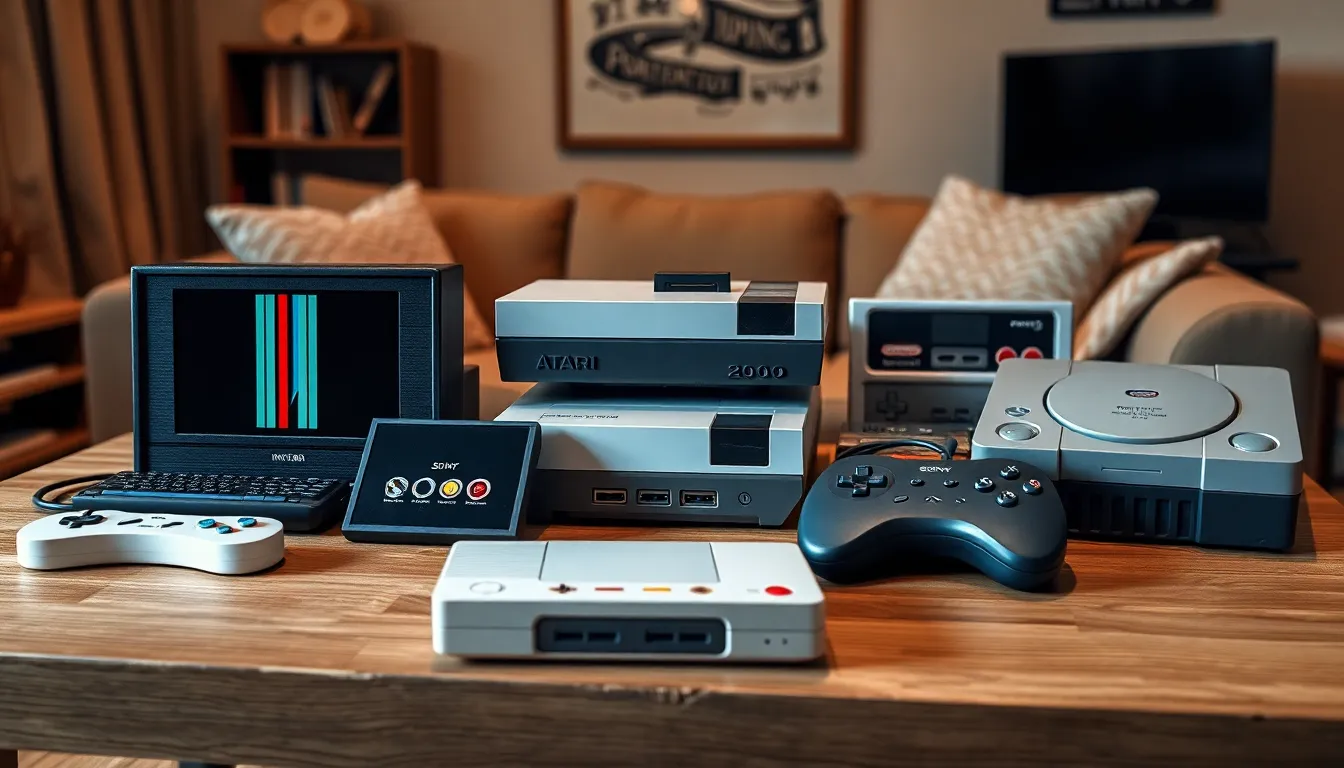Gaming consoles have come a long way since the days of pixelated graphics and joystick battles. They’ve evolved into sleek machines that deliver stunning visuals and immersive experiences. But before the latest gadgets took center stage, a handful of historic consoles laid the groundwork for today’s gaming culture.
Table of Contents
ToggleOverview of Historic Gaming Consoles
Historic gaming consoles played a crucial role in shaping the gaming industry. They introduced innovations that defined gameplay experiences, setting the foundation for future advancements. Pong, released in 1972 by Atari, marked the beginning of arcade gaming, captivating audiences with its simple yet engaging mechanics.
The late 1970s saw the rise of home consoles, exemplified by the Magnavox Odyssey. This console featured interchangeable cartridges, paving the way for future systems. By the early 1980s, the Atari 2600 gained popularity, showcasing 8-bit graphics and introducing players to a diverse library of games.
Nintendos’ NES revolutionized gaming with superior graphics and sound in 1985. It brought iconic franchises like Super Mario Bros and The Legend of Zelda to life, engaging players worldwide. Sega followed suit with the Genesis in 1988, offering a hallmark of 16-bit graphics and fast-paced gameplay.
As technology progressed, Sony entered the scene with the PlayStation in 1994, delivering 3D graphics and CD-ROM capabilities. This innovation shifted the landscape, introducing a new era of gaming possibilities. The Dreamcast, although short-lived, pioneered online gaming in 1998, showcasing early advancements in connectivity.
Throughout the 2000s, consoles such as the Xbox and PlayStation 2 solidified their positions, pushing boundaries in hardware capabilities. These platforms offered multiplayer features and expansive game libraries that enhanced player experience.
Overall, historic gaming consoles reflect significant milestones in gaming history, showcasing technological advancements that laid the groundwork for today’s immersive gaming environments.
The Evolution of Gaming Consoles

The evolution of gaming consoles showcases significant progress in technology and gameplay. Early devices laid the foundation for future innovations, influencing gaming culture.
Early Innovations
Pong introduced in 1972 marked the dawn of interactive gaming. Simple graphics engaged players and drew significant attention. The Magnavox Odyssey followed in 1972, becoming the first home video game console. In its wake, Atari 2600 emerged during the late 1970s, featuring cartridges that allowed players to switch games easily. These early innovations utilized basic controls yet captured the imagination of many. Such advancements established a framework for the gaming industry, encouraging further developments and investments.
The Rise of Home Consoles
The late 1970s and early 1980s heralded the rise of home consoles. The release of the Nintendo Entertainment System (NES) in 1985 transformed the gaming landscape. Enhanced graphics and iconic franchises invigorated player engagement. Sega’s Genesis followed shortly in 1988, contributing notable titles that captivated audiences. Home consoles offered improved access to games, allowing families to experience gaming together. Multiplayer capabilities flourished, setting the stage for social gaming experiences. This shift toward home entertainment solidified gaming’s place in modern culture, paving the way for future innovations.
Iconic Consoles and Their Impact
Historic gaming consoles played a pivotal role in shaping the gaming landscape. They introduced groundbreaking features that transformed the way players interacted with digital entertainment.
Atari 2600
Introduced in 1977, the Atari 2600 became a household name. As one of the first home consoles, it popularized cartridge-based games, allowing players to switch titles easily. Iconic games like “Pong” and “Space Invaders” captured players’ attention, establishing a gaming culture at home. Additionally, the Atari 2600’s user-friendly joystick control set a precedent for future gaming interfaces. Gaming companies began to see the potential in the burgeoning market, paving the way for future innovations.
Nintendo Entertainment System (NES)
The NES, launched in 1985, revitalized the video game industry following the crash of 1983. It introduced iconic titles such as “Super Mario Bros.” and “The Legend of Zelda,” which influenced game design extensively. Advanced graphics and sound capabilities set a new standard for home gaming. The NES also popularized the concept of franchises, creating a loyal fanbase that remains significant in today’s gaming culture. Its strong third-party support further expanded the library, offering diverse gaming experiences for players of all ages.
Sega Genesis
Released in 1988, the Sega Genesis brought competition to the console market. With 16-bit graphics, it offered superior visuals that impressed gamers. Landmark titles like “Sonic the Hedgehog” not only showcased its capabilities but also defined platforming mechanics for years to come. The Genesis introduced features like blast processing, enhancing gameplay speed. It also fostered a vibrant online community, paving the way for multiplayer gaming in future consoles. This impact resonated with players and shaped many aspects of gaming culture.
The Transition to Modern Gaming
The transition from historic gaming consoles to modern systems represents a pivotal shift in gaming. This evolution stems from continuous technological advancements and substantial changes in gaming culture.
Technological Advancements
Modern gaming consoles leverage cutting-edge technology to enhance user experiences. Enhanced graphics capabilities allow for stunning visuals, while powerful processors support complex game mechanics and AI. High-definition displays emerged as essential components, improving clarity and immersion. Online connectivity became standard, enabling multiplayer experiences and downloadable content. Advances in virtual reality technology introduced new dimensions of gameplay, influencing player engagement. Furthermore, cloud gaming offers users access to game libraries without the need for physical media. Each of these advancements redefines standards, continually pushing the envelope in gaming.
Shifts in Gaming Culture
Cultural shifts significantly impacted the gaming landscape. Historically, gaming attracted dedicated enthusiasts who enjoyed solo experiences. Now, gaming communities thrive on social interaction, with multiplayer formats dominating engagement. Esports emerged, transforming gaming into a competitive spectacle with global audiences. Game streaming platforms, like Twitch, fostered connections between players and viewers, creating new content and entertainment avenues. Diverse genres appeal to broader demographics, making gaming accessible to various audiences. These cultural transformations reflect society’s evolving relationship with gaming and its integration into everyday life.
The journey of gaming consoles illustrates a remarkable evolution that has transformed entertainment. From the simple joys of early devices to the immersive experiences offered by today’s technology, each milestone has contributed to a rich gaming culture. These historic consoles laid the groundwork for innovations that continue to shape the industry.
As gaming advances, it reflects not only technological progress but also the changing dynamics of social interaction and community engagement. The legacy of these consoles endures, reminding players of the roots of their favorite pastime while paving the way for future developments. The gaming world is vibrant and ever-changing, ensuring that every player finds their place in this expansive universe.

